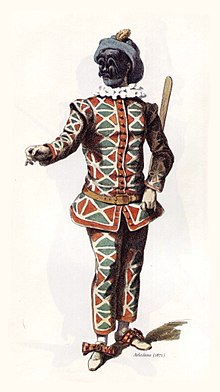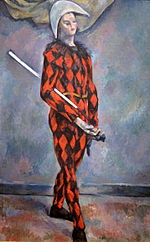Harlequin: Difference between revisions
mNo edit summary |
|||
| Line 48: | Line 48: | ||
*[[Harlequinade]] |
*[[Harlequinade]] |
||
*[[Harley Quinn]] |
*[[Harley Quinn]] |
||
*[["Repent, Harlequin!" Said the Ticktockman]] |
|||
==References== |
==References== |
||
Revision as of 13:23, 15 January 2011
Harlequin or Arlecchino in Italian, Arlequin in French, and Arlequín in Spanish is the most popular of the zanni or comic servant characters from the Italian Commedia dell'arte and its descendant, the Harlequinade.
Origins

The name of Harlequin derives from Old French Hellequin, leader of la maisnie Hellequin, thought to be related to the Old English Herla, a character often identified with Woden.[1][2]
Italian Arlecchino by folk etymology was associated with Latin Herculinus, "little Hercules".[citation needed]
Although illustrations of Arlecchino have only been dated as far back as 1572, the character had existed before this date. The origins of the name are uncertain: some say it comes from Dante's Inferno, XXI, XXII and XXIII; one of the devils in Hell having the name Alichino.
Popular theories suggest that he may have come from France, Africa, or Italy.[3]
The notion that the Harlequin motif grew out of France is evidenced by Hellequin, a stock character in French passion plays. Hellequin, a black-faced emissary of the devil, is said to have roamed the countryside with a group of demons chasing the damned souls of evil people to Hell. The physical appearance of Hellequin offers an explanation for the traditional colours of Harlequin's mask (red and black).[3]
The Harlequin character may have been based on or influenced by the Zanni archetype who, although a slow thinker, was acrobatic and nimble.[4] Interpreted thus, Harlequin's distinctive motley costume may be a stylized variant of Zanni's plain white garb, designed to reflect the ad-hoc patching necessary to prevent the garment's degradation.
Characteristics and dramatic function

The primary aspect of Arlecchino was his physical agility.[3][4] While generally depicted as stupid and gluttonous, he was very nimble and performed the sort of acrobatics the audience expected to see. The character would never perform a simple action when the addition of a cartwheel or flip would spice up the movement.
Within these restrictions the character was tremendously elastic. Various troupes and actors would alter his behavior to suit style, personal preferences, or even the particular scenario being performed. Some of the most famous actors were Tomaso Visentini ("Thomassin"), who performed with the Comédie-Italienne in 18th century France, and Tristano Martinelli.[4]
He is typically cast as the servant of an innamorato or vecchio much to the detriment of the plans of his master. Arlecchino often had a love interest in the person of Columbina, or in older plays any of the Soubrette roles, and his lust for her was only superseded by his desire for food and fear of his master. Occasionally, Arlecchino would pursue the inamorata, though rarely with success, as in the Recueil Fossard of the 16th century where he is shown trying to woo Donna Lucia for himself by masquerading as a foreign nobleman. He also is known to try to win any given lady for himself if he chances upon anyone else trying to woo her, by interrupting or ridiculing the new competitor.
Despite Arlecchino's agility of body, his mind does not entertain the same capacities. He is a slow thinker, with some versions portraying him as able to entertain only one thought at a time[4]—and he is often capable of confusing that, often while pointing at his own butt. This leads to a range of situations, including Lazzi where Arlecchino is tricked into thinking he himself is dead, when other more wily characters of the Commedia dell'Arte point out a range of unlikely symptoms. Pierre Louis Duchartre says that Arlecchino desperately tries to hide his lack of brains, to the point of seeming malicious in so doing; as in one scenario where Arlecchino is diguised as a doctor and prescribes ridiculous "remedies" that would certainly prove fatal if undergone.
He eventually became something more of a romantic hero around the 18th century, when his popularity provoked the Harlequinade.
Variants

Duchartre lists the following as variations on the Harlequin role:
Trivelino or Trivelin. Name is said to mean "Tatterdemalion." One of the oldest versions of Harlequin, dating to the 15th century. Costume almost identical to Harlequin's, but had a variation of the 17th century where the triangular patches were replaced with moons, stars and triangles. In 18th century France, Trivelino was a distinct character from Harlequin. They appeared together in a number of comedies by Pierre de Marivaux including L'Île des esclaves.
Truffa, Truffaldin or Truffaldino. Popular characters with Gozzi and Goldoni, but said to be best when used for improvisations. By the 18th century was a Bergamask caricature.
Guazetto. Costume like the old Zanni's but accessorized with a sort of poncho, or otherwise a giant three-tiered collar. Known for his dancing.
Zaccagnino. Character dating to the 15th century.
Bagatino. A juggler.
See also
References
External links
![]() Media related to Harlequin at Wikimedia Commons
Media related to Harlequin at Wikimedia Commons
Chisholm, Hugh, ed. (1911). Encyclopædia Britannica (11th ed.). Cambridge University Press. {{cite encyclopedia}}: Missing or empty |title= (help)
